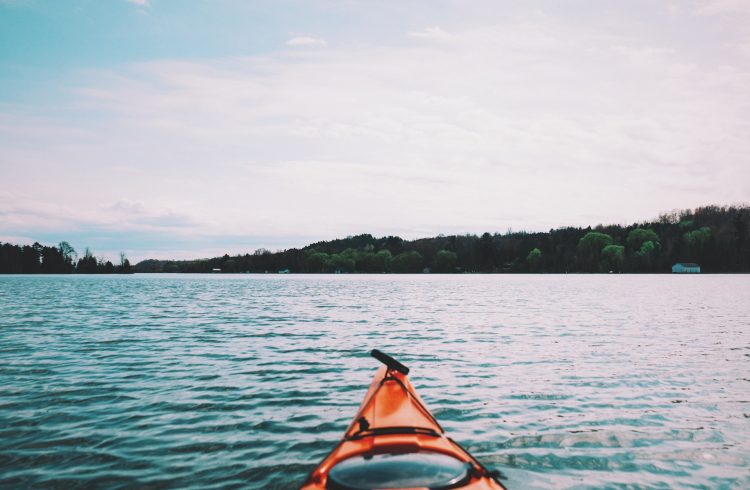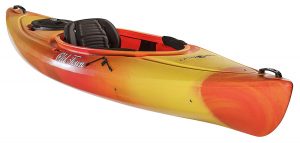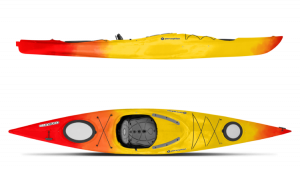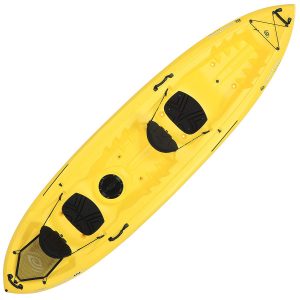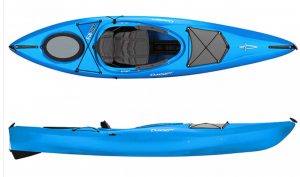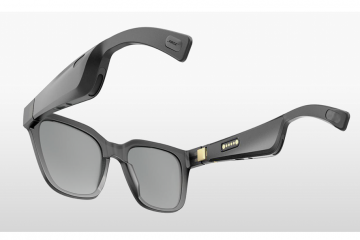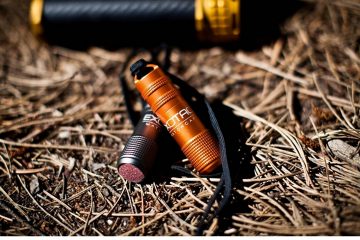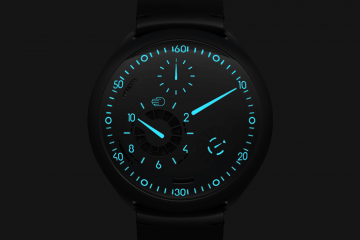Like kayaking? So do we. Kayaking on open water – whether a lake, river or the open ocean –is probably one of most sublime experiences known to man. Just you, the water – and the kayak you’re sitting in. Or maybe you’re an adrenaline junkie and see kayaking as one of the most thrilling experiences known to man – in which case you’ll probably lean towards a faster, slimmer, sleeker kayak for racing down river.
One problem, of course – kayaks are expensive. So how do you go about getting into this incredible pastime when you’re on a budget? What about if you’re just trying it out and don’t want to go about spending a week’s paycheck on a vessel?
Don’t worry – you’re in luck. There’s still a good selection of affordable kayaks available with all the quality and features you need but without the hefty price tags you don’t. Check out our list of the 10 Best Affordable Kayaks of 2018 and see which one suits you best.
Contents
- First, How To Choose A Kayak on A Budget?
- Breaking Down Types of Kayaks
- Whitewater Kayaks
- Recreational Kayaks
- Touring Kayaks
- Sea Kayaks
- Fishing Kayaks
- What About Kayak Materials?
- Composite/Fiberglass
- Rotomolded/Polyethylene
- Thermoform
- Enough Talk. What Are The Best Kayaks of 2018?
- OLD TOWN HERON 9XT
- Ocean Kayak Malibu Two
- Perception Conduit
- EMOTION SPITFIRE TANDEM
- Perception Sound
- Dagger Axis Crossover 10.5
First, How To Choose A Kayak on A Budget?
For the purposes of this list, we’re looking at kayaks between $400 and about $700. (Some – like the Dagger Axis – might cost a bit more and stretch that definition). Everybody’s definition of “affordable” is a little bit different, but to get a true polyethylene kayak (see below as to why you’re looking for polyethylene), you’ll need to spend at least that much. If that’s still stretching your budget, you’ll likely want to look into an inflatable kayak or something similar.
But once you’ve decided on your budget and are ready to start looking at kayaks, you’ll need to ask yourself a few questions:
Where Do You Plan On Using It? A traditional kayak meant for use on rivers and quiet lakes won’t perform well on the ocean.
Do You Want A Sit In, Or A Sit On Top? Sit-in kayaks are the traditional style, but are found on virtually any style of kayak – deep sea or whitewater, even. Sit On Tops don’t offer as much protection from the elements, but are easier to enter and exit – just hop in and hop out.
How Much Cargo Do You Need To Carry? Probably not a lot, but the larger the more boat and the more cargo space it has – the more expensive it will likely be. If you’re interested in overnight rafting trips, you’ll probably want to look into a packraft.
How Long Do You Need? Generally, the longer the kayak, the slimmer, sleeker and faster it will be. Touring kayaks are an example, while everyday recreational kayaks are generally shorter. Shorter kayaks – like whitewater kayaks – can be more stable on choppy, rough water.
Breaking Down Types of Kayaks
There’s a smattering of different kayak styles, and while no single style is the “best kayak”, each one has their own unique advantages and will excel at its own intended use.
Whitewater Kayaks
Whitewater kayaks don’t have keels, and don’t track in a straight line. As a result, they are easily maneuverable – making them an excellent choice for navigating choppy and rough waters and rocks. They’re also usually quite short – often less than 10 feet – as this makes them a bit more stable and nimble and feature curved hulls and flat fronts for even more stability.
Recreational Kayaks
Recreational kayaks are good all-rounders, generally for beginners who don’t know much about the sport and just want some way to get out on the open water and get kayaking – and for people who just aren’t picky. They’re usually longer than whitewater kayaks but not as long as touring kayaks; you’ll usually find them between 10 and 14 feet long – usually 12 or under. Cheap and stable.
Touring Kayaks
As you get more comfortable with your kayak and start embarking on longer trips, you may want to upgrade to a touring kayak. These are slimmer and sleeker than recreational kayaks, and also longer, allowing them to glide smoothly and quickly through the water. Most touring kayaks are between 12 and 16 feet long and feature lifted hulls. They’ll also generally have plenty of cargo space and often a rudder – which his likely never found on a recreational kayak.
Sea Kayaks
Sea kayaks are much like touring kayaks and are often lumped together with them. They’re designed for open water, however, and are quite long – usually 17 or 18 feet long. They have smaller cockpits and openings than regular touring kayaks, and a whole host of features to make them sea-ready, such as the skeg. The skeg helps them steer better on rough water and in open winds, and it doesn’t need to be used, as you can raise or lower it in and out of the water. But if you need it when the wind kicks up, it’s there.
Fishing Kayaks
There aren’t a lot of kayaks designed specifically for fishing, but those that are, are usually shorter, broad and relatively light, with storage for stashing your fishing gear and features to make fishing easier, like rod holders on the side.
What About Kayak Materials?
The material your kayak is made of isn’t as important as the style but can definitely make a huge difference when choosing the right one. Here’s a quick summary of the most commonly-used kayak materials.
Composite/Fiberglass
Most kayaks are made of a composite material – usually fiberglass, but now often the superlight aramid or graphite. These composite materials/fabrics are laid onto each other in layers with glue, before being applied to a mold of the kayak. Fiberglass kayaks, in addition, have a layer of gel coating on the inside of the mold, which then dries and becomes the outer surface of the kayak when the mold is removed.
Composite kayaks are fast, nimble and sleek, as well super light and very durable.
Rotomolded/Polyethylene
The cheapest kayaks are generally made of polyethylene, rotomolded into a durable – albeit heavy kayak. When we say heavy, we mean it – but the cheap price helps make up for their excessive weight. The plastic, one-piece construction is also very good for rocky water, as they can bounce right off rocks pretty easily.
Thermoform
Thermoform kayaks are made from sheets of ABS plastic, sucked by a vacuum over the mold in two parts – the hull and deck. They are then joined together, with a clear coat of acrylic on top for durability and protection from the sun; UV rays can degrade and deteriorate the plastic over time.
Thermoform kayaks are cheaper than composites, but lighter and more durable than rotomolded kayaks, and thus faster. They are not, however, as fast as true composite/fiberglass kayaks.
Enough Talk. What Are The Best Kayaks of 2018?
OLD TOWN HERON 9XT
For less than $500, you can snag this recreational kayak from Old Town, one of the more-trusted names when it comes to kayaks. Made from a single layer of rotomolded polyethylene, this kayak has been designed to strike the perfect balance of comfort, maneuverability and cheap price tag – and for that it delivers. It’s 9.5 feet long, feels stable on the water, and has a comfort-flex seat with tons of padding for a comfortable ride, all-day long. There’s a decent amount of storage space for a kayak of this size, as well as thigh pads and foot braces. The polyethylene build is good for most general use, is pretty durable, and it weighs only 39 pounds – not bad at all for a kayak of this price.
Ocean Kayak Malibu Two
Ocean Kayak is another well-known kayak maker, and they make some of the most popular models out there. The Malibu Two is a lightweight tandem kayak made of a single-layer polyethylene, measuring 12 feet long and with a weight capacity of 425 lbs. That’s less than the eMotion Spitfire Tandem, but generally enough for two people. It has two Comfort Plus seatbacks, molded-in seat wells and overlapping foot wells, which give more comfortable foot bracing when a single kayaker is seated in the middle of the vessel. There’s not much storage when seating two, but there are several gear handles. And in addition to the polyethylene build, it’s got a skid plate, making for one incredibly-tough and durable boat.
Again, it might be stretching the limits of “affordable,” but the Malibu Two is a high-quality, durable and versatile kayak for two. And, it only weighs 62 pounds, compared to the Spitfire Tandem’s 90.
Perception Conduit
The Perception Conduit is an excellent kayak for beginners and those just looking into buying their first kayak without spending too much dough. At 13 feet long, it’s good for lakes, ponds and rivers where the water is relatively flat, and provides just the right balance of some speed (the moderate length) and stability (the width), as well as agility and ability to maneuver. You can even use it for sea kayaking, provided the water is mild and not too choppy.
The Conduit is made from a UV-resistant, high-density polyethylene, and is designed, rotomolded and then hand-assembled entirely in the USA. We love America-made stuff, so that bumps it up a few more notches in our book. It weighs only 51 pounds and has a weight capacity of 295 pounds. The sit-in seats are wide enough to get in and out of comfortably, and it has ample ergonomic support and padding, with a Keepers foot brace system and several thigh pads. For the price, the Conduit is the perfect combination of speed, stability and reliable construction; Perception backs it up with a 5-Year Warranty.
EMOTION SPITFIRE TANDEM
If you want to bring someone along for the ride, the Emotion Spitfire is a solid tandem kayak at a decent price. This sit-on-top kayak is 12 feet long, made from rotomolded polyethylene, and weighs a whopping 90 pounds, but brings with it a solid 500-pound weight capacity. For maximum comfort, the seats are padded CRS + UltraLite seats, which can be quick-released, and it also has molded footwells, which are adjustable and can fit paddlers of all sizes. In the centers, there’s a storage hatch, as well as a rear tank well and cargo lacing system so you can store virtually everything you need. And, since it’s a sit-on-top kayak, it’s very easy to get in and out of. eMotion also backs it up with a 5-year warranty.
Generally found in the $600-$700 range, it’s getting up there on the “Affordable” list, but for a high-quality, durable tandem kayak with all the comfort and features you need, it won’t break the bank. What else could you ask for?
Perception Sound
The Sound is the perfect fishing kayak for those of us who like fishing on the water, but have no money. At 9 feet, 6 inches long, it’s stable for long periods of sitting still on the water and features a Tri-Keel Hull, which makes it easy to steer and track straight. Behind the main seat there is ample storage space with bungee straps, the dashboard features mounting points for accessories, and the molded-in rod holders make fishing easy.
It’s short length (9 feet, 6 inches) means it’s very light, too, coming in at only 38 pounds; max weight capacity is 38 pounds.
As you might expect from a kayak in this price range, Perception built the Sound (entirely in the USA) out of their typical high-density polyethylene, which is UV-resistant and means it’s built like a tank. It’s short length (9 feet, 6 inches) means it’s very light, too, as it comes in at only 38 pounds; max weight capacity is 295 pounds.
If you’re trying to break into the world of kayak fishing without breaking the bank, Perception has you covered – again.
Dagger Axis Crossover 10.5
If you want a kayak that can do almost anything, it might be a good idea to opt for a crossover kayak, like the Dagger Axis. This recreational kayak is designed to be as versatile as possible, whether you’re floating on the lake or running a river. At 10.5 feet long, it’s short and stable enough for virtually anything while still light enough (only 50 pounds) to get some speed. The hull is stable enough for beginning kayakers, and there are defined chines for more maneuverability. It’s also got nearly-endless features, such as a Contour CFS seating system with height-adjustable backrest, ConTour Thigh pads and leg rests, and a SlideLock foot brace system. Storage room is plenty, with a stern hatch with bulkhead for dry storage, plenty of bungee rigging, and a mesh pocket attached to the bow deck.
Made from rotomolded polyethylene, it’s ultra-durable, and features a TruTrak adjustable skeg system. This is truly a versatile kayak for boating in virtually any water, and while it’s definitely stretching the definition of “affordable” a bit, it’s the perfect choice when you feel like boating everywhere but can only afford a single kayak.
